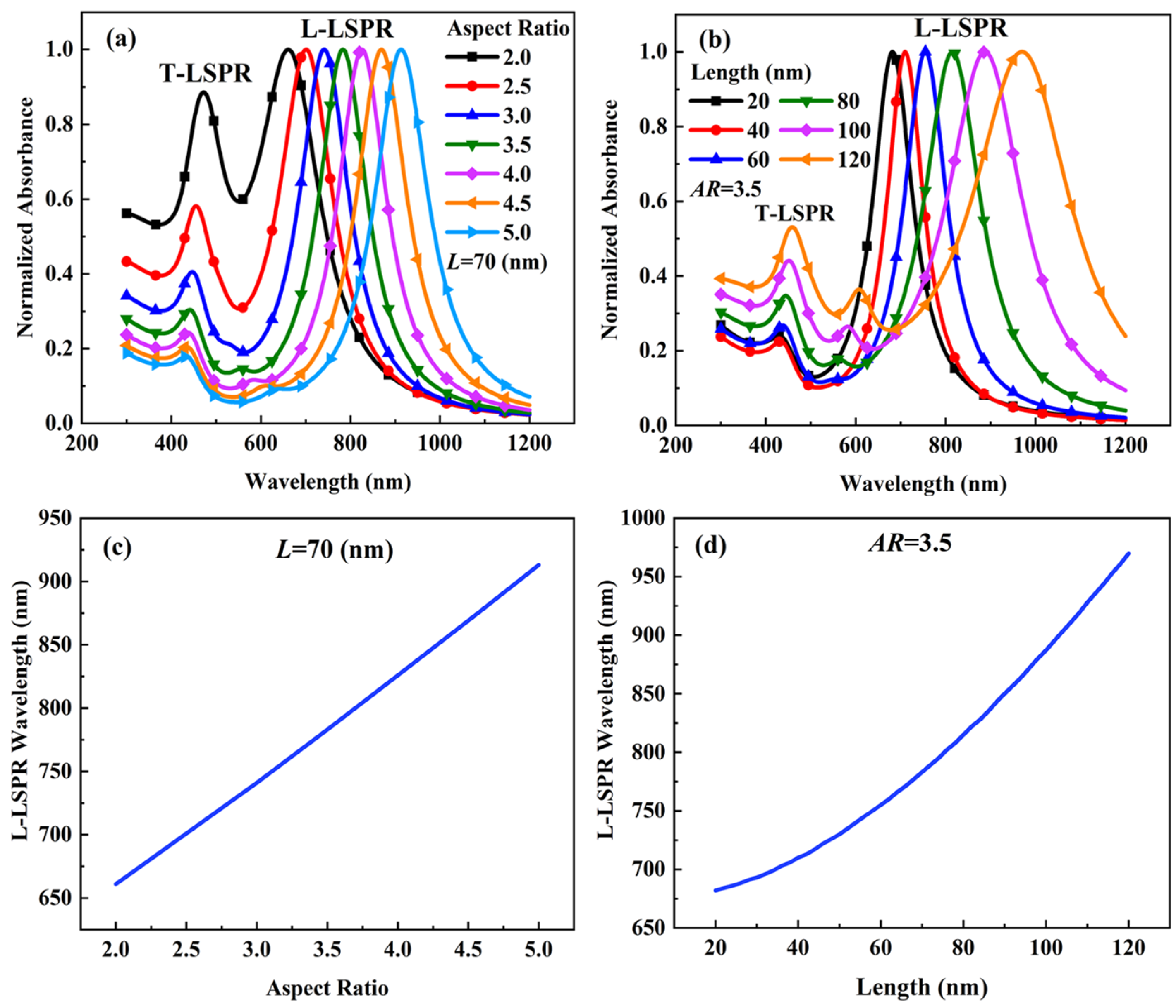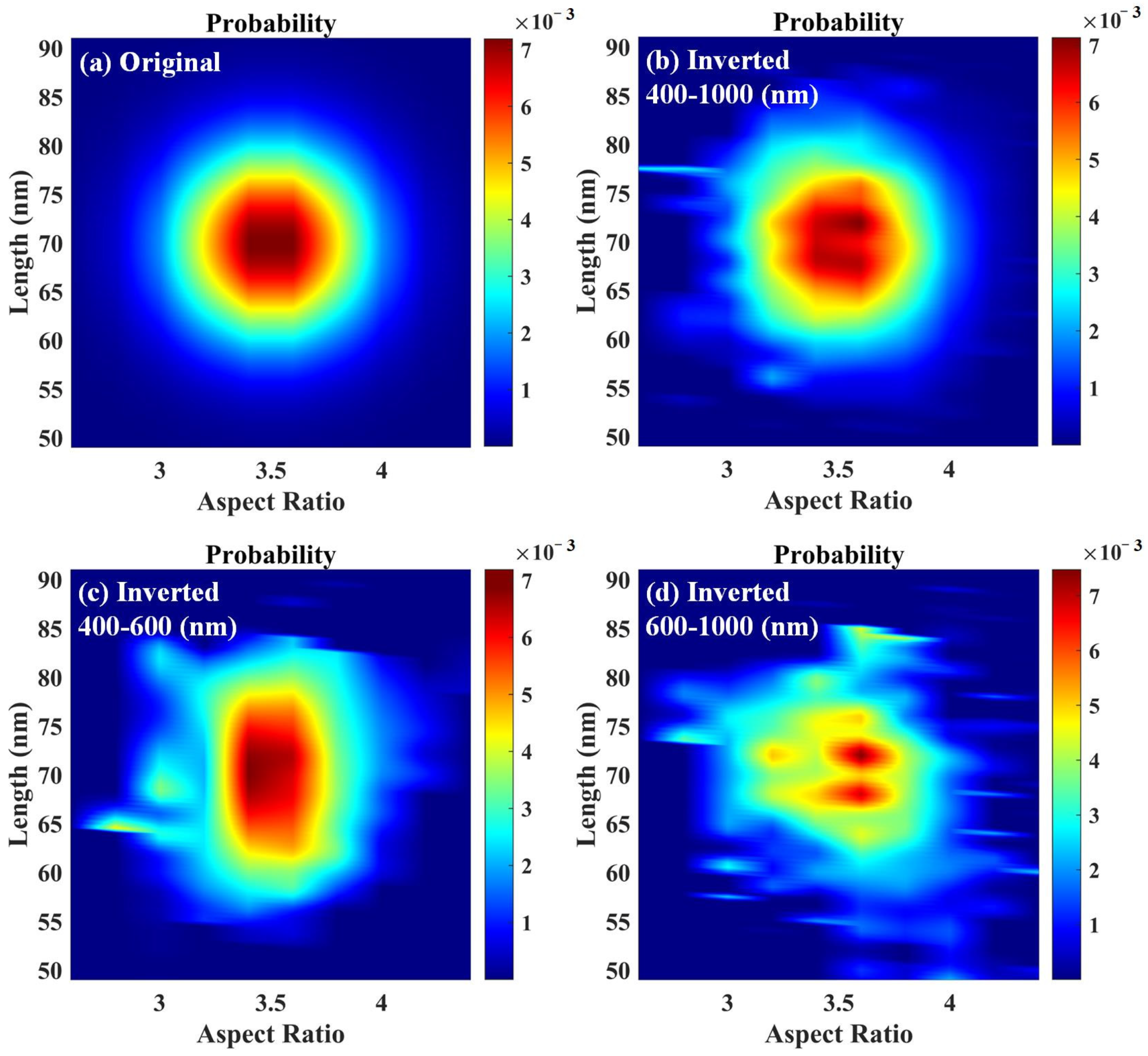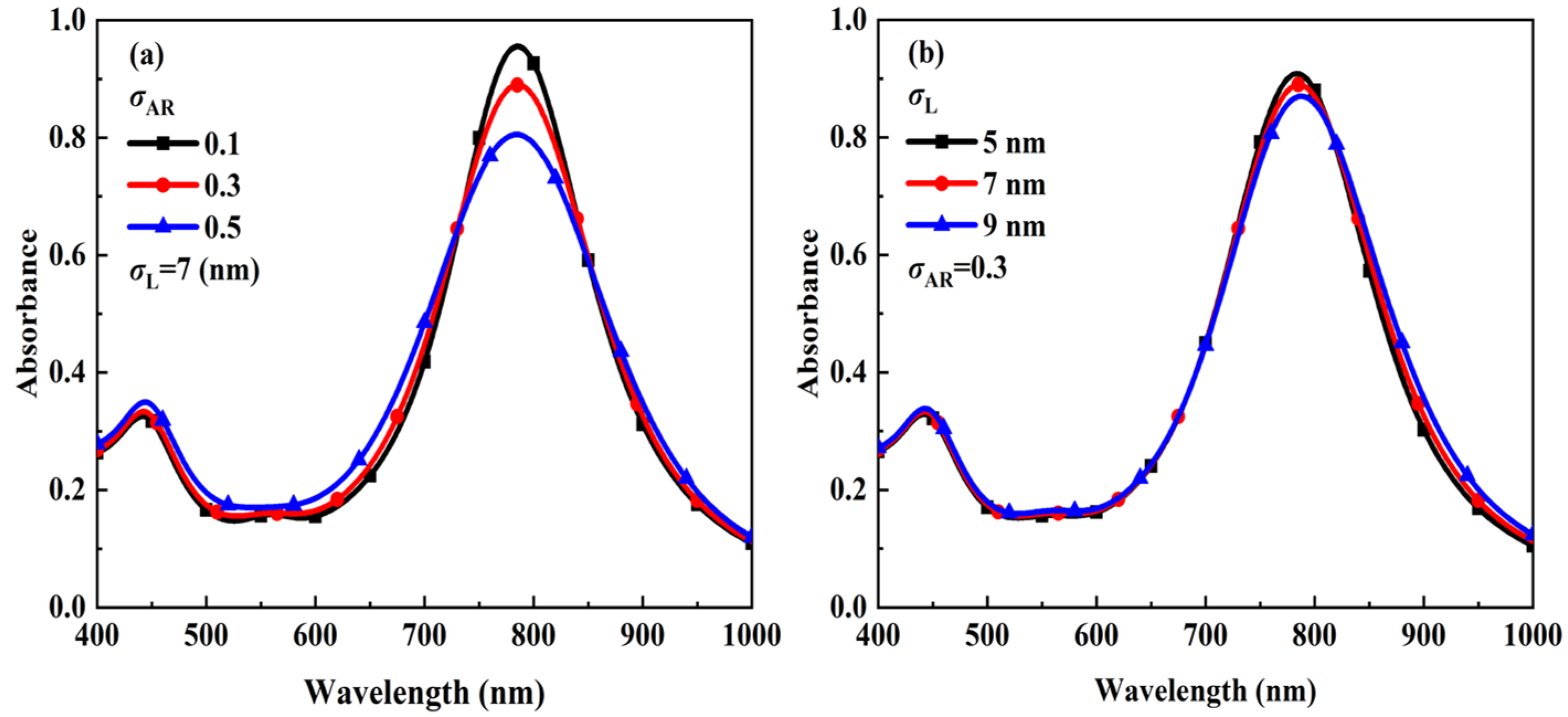Retrieval of Size Distribution and Concentration of Au-Ag Alloy Nanospheroids by Spectral Extinction Method
Abstract
:1. Introduction
2. Theoretical Methods
3. Results and Discussion
4. Conclusions
Author Contributions
Funding
Institutional Review Board Statement
Informed Consent Statement
Acknowledgments
Conflicts of Interest
References
- Barnes, W.L.; Dereux, A.; Ebbesen, T.W. Surface plasmon subwavelength optics. Nature 2003, 424, 824–830. [Google Scholar] [CrossRef] [PubMed]
- Wang, J.H.; Yang, Y.H.; Li, H.; Gao, J.; He, P.; Bian, L.; Dong, F.Q.; He, Y. Stable and tunable plasmon resonance of molybdenum oxide nanosheets from the ultraviolet to the near-infrared region for ultrasensitive surface-enhanced Raman analysis. Chem. Sci. 2019, 10, 6330–6335. [Google Scholar] [CrossRef] [PubMed] [Green Version]
- Wang, J.P.; Sun, J.Y.; Hu, W.; Wang, Y.H.; Chou, T.M.; Zhang, B.L.; Zhang, Q.; Ren, L.; Wang, H.J. A porous Au@Rh bimetallic core-shell nanostructure as an H2O2-driven oxygenerator to alleviate tumor hypoxia for simultaneous bimodal imaging and enhanced photodynamic therapy. Adv. Mater. 2020, 32, 2001862. [Google Scholar] [CrossRef]
- Weng, Y.Z.W.; Guan, S.Y.; Wang, L.; Lu, H.; Meng, X.M.; Waterhouse, G.I.N.; Zhou, S.Y. Defective porous carbon polyhedra decorated with copper nanoparticles for enhanced NIR-driven photothermal cancer therapy. Small 2020, 16, 1905184. [Google Scholar] [CrossRef]
- Fathi, F.; Rashidi, M.R.; Omidi, Y. Ultra-sensitive detection by metal nanoparticles-mediated enhanced SPR biosensors. Talanta 2019, 192, 118–127. [Google Scholar] [CrossRef]
- Kaya, S.I.; Kurbanoglu, S.; Ozkan, S.A. Nanomaterials-based nanosensors for the simultaneous electrochemical determination of biologically important compounds: Ascorbic acid, Uric Acid, and dopamine. Crit. Rev. Anal. Chem. 2019, 49, 101–125. [Google Scholar] [CrossRef]
- Sareen, S.; Mutreja, V.; Pal, B.; Singh, S. Synthesis of bimetallic Au-Ag alloyed mesocomposites and their catalytic activity for the reduction of nitroaromatics. Appl. Surf. Sci. 2018, 435, 552–562. [Google Scholar] [CrossRef]
- Tan, S.F.; Chee, S.W.; Lin, G.H.; Bosman, M.; Lin, M.; Mirsaidov, U.; Nijhuis, C.A. Real-time imaging of the formation of Au-Ag core-shell nanoparticles. J. Am. Chem. Soc. 2016, 138, 5190–5193. [Google Scholar] [CrossRef]
- Wang, W.J.; Liu, J.; Feng, W.J.; Du, S.L.; Ge, R.; Li, J.; Liu, Y.; Sun, H.C.; Zhang, D.Q.; Zhang, H.; et al. Targeting mitochondria with Au-Ag@Polydopamine nanoparticles for papillary thyroid cancer therapy. Biomater. Sci. 2019, 7, 1052–1063. [Google Scholar] [CrossRef]
- Chen, M.J.; He, Y.R.; Zhu, J.Q. Preparation of Au-Ag bimetallic nanoparticles for enhanced solar photothermal conversion. Int. J. Heat Mass Transf. 2017, 114, 1098–1104. [Google Scholar] [CrossRef]
- Wang, M.H.; Liu, J.J.; Qin, X.T.; Nie, X.; Dong, Y.F.; Liang, X.; Zhu, Z.W.; Yang, D.; Shao, Y.H. Electrochemiluminescence detection of cardiac troponin I based on Au-Ag alloy nanourchins. Analyst 2020, 145, 873–879. [Google Scholar] [CrossRef]
- Yu, K.K.; Sun, X.N.; Pan, L.; Liu, T.; Liu, A.P.; Chen, G.; Huang, Y.Z. Hollow Au-Ag alloy nanorices and their optical properties. Nanomaterials 2017, 7, 255. [Google Scholar] [CrossRef] [PubMed]
- Chander, N.; Khan, A.F.; Thouti, E.; Sardana, S.K.; Chandrasekhar, P.S.; Dutta, V.; Komarala, V.K. Size and concentration effects of gold nanoparticles on optical and electrical properties of plasmonic dye sensitized solar cells. Sol. Energy 2014, 109, 11–23. [Google Scholar] [CrossRef]
- Xu, C.; Tung, G.A.; Sun, S. Size and concentration effect of gold nanoparticles on X-ray attenuation as measured on computed tomography. Chem. Mater. 2008, 20, 4167–4169. [Google Scholar] [CrossRef] [PubMed] [Green Version]
- Hinterwirth, H.; Wiedmer, S.K.; Moilanen, M.; Lehner, A.; Allmaier, G.; Waitz, T.; Lindner, W.; Lammerhofer, M. Comparative method evaluation for size and size-distribution analysis of gold nanoparticles. J. Sep. Sci. 2013, 36, 2952–2961. [Google Scholar] [CrossRef]
- Ren, K.; Xu, F.; Cai, X.; Dorey, J.M. Development of a precise and in situ turbidity measurement system. Chem. Eng. Commun. 2010, 197, 250–259. [Google Scholar] [CrossRef]
- Khlebtsov, B.N.; Khanadeev, V.A.; Khlebtsov, N.G. Observation of extra-high depolarized light scattering spectra from gold nanorods. J. Phys. Chem. C 2008, 112, 12760–12768. [Google Scholar] [CrossRef]
- Khlebtsov, B.N.; Khanadeev, V.A.; Khlebtsov, N.G. Extinction and extra-high depolarized light scattering spectra of gold nanorods with improved purity and dimension tunability: Direct and inverse problems. Phys. Chem. Chem. Phys. 2014, 16, 5710. [Google Scholar] [CrossRef]
- Xu, N.H.; Bai, B.F.; Tan, Q.F.; Jin, G.F. Fast statistical measurement of aspect ratio distribution of gold nanorod ensembles by optical extinction spectroscopy. Opt. Express 2013, 21, 2987–3000. [Google Scholar] [CrossRef]
- Mishchenko, M.I.; Mackowski, D.W.; Travis, L.D. T-matrix computations of light scattering by nonspherical particles: A review. J. Quant. Spectrosc. Radiat. Transf. 1996, 55, 535–575. [Google Scholar] [CrossRef]
- Mishchenko, M.I.; Travis, L.D.; Mackowski, D.W. T-matrix method and its applications to electromagnetic scattering by particles: A current perspective. J. Quant. Spectrosc. Radiat. Transf. 2010, 111, 1700–1703. [Google Scholar] [CrossRef] [Green Version]
- Rioux, D.; Vallières, S.; Besner, S.; Muñoz, P.; Mazur, E.; Meunier, M. An analytic model for the dielectric function of Au, Ag, and their alloys. Adv. Opt. Mater. 2014, 2, 176–182. [Google Scholar] [CrossRef]
- Daimon, M.; Masumura, A. Measurement of the refractive index of distilled water from the near-infrared region to the ultraviolet region. Appl. Opt. 2007, 46, 3811–3820. [Google Scholar] [CrossRef] [PubMed]
- Hansen, P.C. Regularization tools: A Matlab package for analysis and solution of discrete ill-posed problems. Numer. Algorithms 1994, 6, 1–35. [Google Scholar] [CrossRef] [Green Version]
- Mroczka, J.; Szczuczynski, D. Simulation research on improved regularized solution of the inverse problem in spectral extinction measurements. Appl. Opt. 2012, 51, 1715–1723. [Google Scholar] [CrossRef] [PubMed]
- Mroczka, J.; Szczuczyński, D. Improved regularized solution of the inverse problem in turbidimetric measurements. Appl. Opt. 2010, 49, 4591–4603. [Google Scholar] [CrossRef]





| Parameters | Ranges | Step-Size |
|---|---|---|
| Wavelength (nm) | 300–1200 | 2 |
| Aspect Ratio | 1.0–5.0 | 0.1 |
| Length (nm) | 20–120 | 2 |
| ΔL | 0.5 | 1.0 | 1.5 | 2 | 2.5 | |
|---|---|---|---|---|---|---|
| Error (%) | ||||||
| ΔAR | ||||||
| 0.1 | 0.05 2.52 0.10 1.43 0.14 | 0.04 2.30 0.10 1.59 0.16 | 0.03 2.50 0.11 1.75 0.17 | 0.02 1.82 0.05 0.61 0.07 | 0.03 1.98 0.10 0.57 0.09 | |
| 0.2 | 0.01 0.85 0.04 0.09 0.07 | 2.77 27.50 5.52 62.46 12.69 | 0.02 1.04 0.05 0.32 0.07 | 0.02 1.18 0.07 0.87 0.10 | 4.87 52.38 8.80 85.08 21.36 | |
| 0.3 | 0.01 0.24 0.01 0.92 0.01 | 0.08 2.58 0.08 1.50 0.08 | 0.10 2.94 0.09 2.05 0.10 | 0.09 2.94 0.07 1.79 0.07 | 0.04 2.13 0.07 0.16 0.06 | |
| 0.4 | 0.07 1.18 0.13 3.98 0.24 | 0.07 1.19 0.12 3.64 0.23 | 0.06 1.28 0.08 2.60 0.14 | 0.03 1.33 0.01 0.85 0.04 | 0.02 1.42 0.08 0.60 0.09 | |
| 0.5 | 0.15 1.90 0.08 1.13 0.24 | 0.17 2.20 0.04 2.52 0.19 | 0.17 2.42 0.17 2.89 0.15 | 0.18 2.24 0.13 0.01 0.34 | 0.38 10.79 0.07 6.66 0.46 | |
| Parameters | Original | Inverted | Relative Error (%) |
|---|---|---|---|
| ARm | 3.5 | 3.52 | 0.57 |
| σAR | 0.3 | 0.32 | 6.67 |
| Lm | 70.0 nm | 69.20 nm | 1.14 |
| σL | 7.0 nm | 8.10 nm | 15.71 |
| N | 1 × 1010 particles/cm3 | 1.0245 × 1010 particles/cm3 | 2.45 |
Publisher’s Note: MDPI stays neutral with regard to jurisdictional claims in published maps and institutional affiliations. |
© 2022 by the authors. Licensee MDPI, Basel, Switzerland. This article is an open access article distributed under the terms and conditions of the Creative Commons Attribution (CC BY) license (https://creativecommons.org/licenses/by/4.0/).
Share and Cite
Zheng, Y.; Tuersun, P.; Abulaiti, R.; Ma, D.; Cheng, L. Retrieval of Size Distribution and Concentration of Au-Ag Alloy Nanospheroids by Spectral Extinction Method. Materials 2022, 15, 1778. https://doi.org/10.3390/ma15051778
Zheng Y, Tuersun P, Abulaiti R, Ma D, Cheng L. Retrieval of Size Distribution and Concentration of Au-Ag Alloy Nanospheroids by Spectral Extinction Method. Materials. 2022; 15(5):1778. https://doi.org/10.3390/ma15051778
Chicago/Turabian StyleZheng, Yuxia, Paerhatijiang Tuersun, Remilai Abulaiti, Dengpan Ma, and Long Cheng. 2022. "Retrieval of Size Distribution and Concentration of Au-Ag Alloy Nanospheroids by Spectral Extinction Method" Materials 15, no. 5: 1778. https://doi.org/10.3390/ma15051778
APA StyleZheng, Y., Tuersun, P., Abulaiti, R., Ma, D., & Cheng, L. (2022). Retrieval of Size Distribution and Concentration of Au-Ag Alloy Nanospheroids by Spectral Extinction Method. Materials, 15(5), 1778. https://doi.org/10.3390/ma15051778





